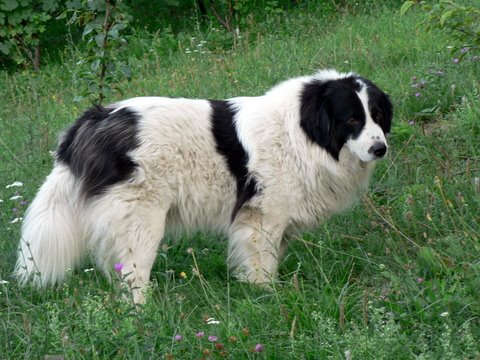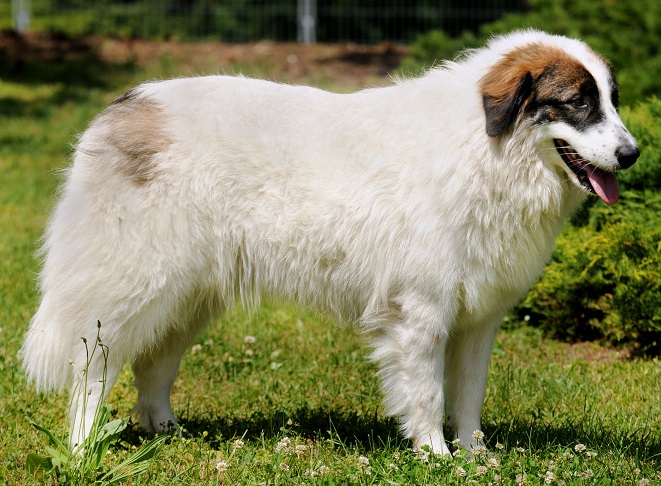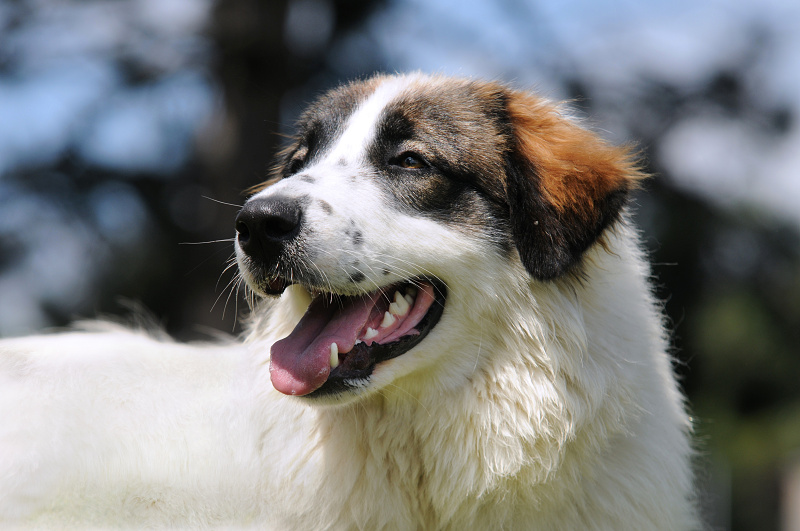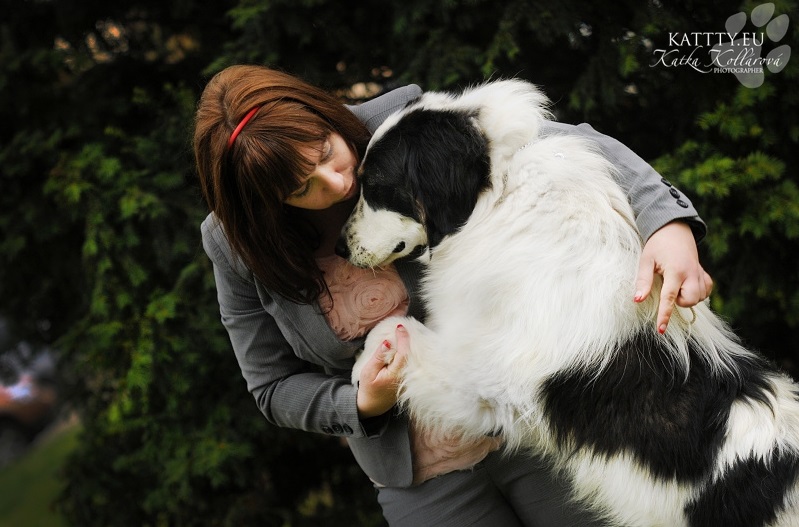Tornjak
About Tornjak
We are glad, that we bring the very first tornjaks to Czech Republic. Becouse this breed is not so famous, we bring you also a few infos about it.
Tornjak is an old livestock guardian dog whose exclusive function during centuries was to protect the herd and property from intruders, wild animals and robbers. That task they do still today although in last couple of years they find new role as guardian of the property or they have pure pet role.
This breed has existed in Bosnia and Herzegovina for the past thousand years, and it can be proven with written documents. At this time the tornjak was registered under the name Kanis montanus. Which translates to mountain dog. But the local people gave it the name tornjak (tor: enclosure for sheep, and cattle). Tornjak was registered as autochthonous breed on May 9, 1981 with the name "Bosnian-Herzegovinian sheepdog - tornjak."At that time Yugoslavian pedigree was opened for the tornjak. A judge commission was formed with the goal to do everything needed for the standard of the breed and it's recognition with the FCI as an autochthonous breed with the above mentioned name. The standard was done on 10.05.1990 in Travnik (a town in central Bosnia).
In 1970's tornjaks were very rare and they faced the threat of certain extinction. Those years, when the group of enthusiast initiated the tours in the areas in Croatia and in Bosnia & Herzegovina in search for the examples whose characteristics match the descriptions of old manuscripts from the year 1067 and 1374, stated the process of saving the tornjak from extinction. Shortly after, in 1979. in Zagreb (Croatia), the first Tornjak Breeding Commission was established and official breeding process has started in 1982. under the patronage of Croatian Kennel Association (HKS).
Tombstone from 14 Century in Bosnia
In general, tornjaks are calm animals, good-natured and first of all, steadily and balanced dogs that like order and harmony. Gentle and emotive toward family members, tolerant towards strangers if properly socialized as a pup and friendly even to a unknown child hanging on their neck. However, also they are big, powerful, territorial, self-confident and in particular measure independent dogs that become curious and defensive if something unusual happens on their territory and offensive too, if situation demands such a reaction. And exactly because of that characteristic they are considered as the best choice to protect livestock, especially in areas where exists danger of intrusion of wild canids and other predators. It is not necessary to induce and develop protective instinct of such dogs because it will be developed spontaneously with maturing.

Avani Boss-tor
Tornjak, as well as all other old LGD has exceptional intelligence and ability of quick learning, but that doesn't mean that he will do all the time just what is from him required. Those are the dogs who tend to estimate the situation and to make quick decision all by them self and that is the reason why is gentle, but strong, patient and persistent upbringing with many love is necessary.
In distinction from sheep dog and cattle dog who are very agile, but physically week and essentially unsuitable for herd defense, livestock guardian dogs (LGDs) tend not to move to much. Beside their size and physical strength, their self confidence and a dose of indifference toward daily routines their exceptional guardian instinct makes them a bit unique in a dog's population.
About barkong there are two opinions:
1)As a general rule, Tornjaks bark a lot. That is component part of their nature and their purpose, namely those dogs will react on every unusual noise or motion near the area that they protect and they will warn with barking on a possible source of a menace or a danger. Our Tornjak lives with us in the house so he barks rarely. Inside the house they are calm and undemanding, but outside they are very alert although often they don't give such impression at all.
2)It is also a dog that barks very little, mostly it only warns its owner about the danger than awaits orders. In Bosnia they say that it is "poor with barking". They partly ascribe it to history, when Turkish conquerors were passing Bosnia and supposedly killed aggressive and barking dogs. Because of this only cautious dogs survived. Tornjaks are supposed to have hereditary instinct for sheep guarding and practically don't need any training. Because of all this tornjak is one of the leading sheepdogs in Bosnia and Herzegovina.
I think it depends on each dog...:o) At our home, there are tornjaks barknig on all what moves and tornjaks who barks just sometimes.
A Tornjak's exercise levels are usually not demanding, especially in the first 9 – 12 months (during the last intensive growth period). After that they can exercise as much as possible. They prefer long walks without a leash and a lot of playing with other dogs. The Tornjak will also be just as satisfied with only a 20 minute walk if its owner is in a hurry. Tornjaks learn quickly and do not forget easily; they happily perform tasks and are therefore easy to train. Strong and hardy, during the snowy winter nights, these dogs lie on the ground and often get covered by snow without freezing due to their thick coats. They are used for herding and protection of livestock.
Typical commands (and our expectations) like come, sit, place, on foot, bring - will left them indifferent. It is not that they won't obey nor because they are stubborn. The reason is simple that they don't see sense in following those commands, according to them not so important request (outside they are always alert and on duty). It is not that they will refuse to do what we want a priori. Indeed the speed with whom they are willing and able to learn and accept the "theory" is impressive, but those are the dogs who tend to make decisions whether they will and when they will do something in praxis, especially as adult dogs. Their calmness and in appearance indifference will trick everybody who doesn't know those dogs, but in essence they are always alert and awake. Transformation from completely calmness to full activity takes place in a blink of an eye especially if they estimate that they need to react.
The Tornjak is not recommended for apartment life. They need space and will do best with at least a large yard. Because its thick coat protects it so well, it can happily cope with living out-doors provided it has proper shelter.
Tornjak is a very healthy breed, but because they were very poorly fed in their past, they now do not need so much proteins in the food. For feeding Tornjaks a low protein diet is suitable. Too high a protein content can lead to the development of coat problems. Climbing up and downstairs the first six months can ruin theirs hock joints or lead to hip dysplasia.
Tornjak needs early socialization. Early experiences, before 9 months of age, have a very significant effect throughout the dog's life. They need to be confronted with all potentially fearful stimuli as early as possible, in order to avoid later fear reactions. Traffic noise, big trucks and buses will provoke fear reactions in adulthood, if the Tornjak has not previously faced these situations several times as a puppy. In this early age all Tornjak puppies have to meet as many strange people as possible, and also other animals, dogs, and pets especially, for developing a good and stable behaviour as an adult. No special training or equipment is needed.

APPEARANCE
Tornjak is a strong, large well connected and supple dog. Bones are neither light nor massive or heavy. Desirable size approximately 70 cm tall for male, 60 - 65 cm for females. In general, the Tornjak is a long coated dog with short hair over the face and legs. The topcoat is long, thick, coarse and straight. It is specially long on the upper part of the croup, over the shoulders and the back it can also be slightly wavy. Tornjak is a trotter. Movement is vivacious, can have relatively shorter and higher gait, but always abundantly, supple and alert. Length of the body about 8% the height of the male dogs, and 10% the height of the females. The height of the chest is 45% of the total height, but deeper chest is also allowed. Tornjaks are friendly with people, but aggressive towards other animals and dogs that threaten his owner, home, sheep pen or the flock. They like to work and take commands readily form their owners.
Tornjak are multicolored dogs. White base covers more or less with portions in other colour(s). Either dark colour all over the body (mantle) with white only around neck, on head and legs; or almost entirely white animal with few marking, but always with spots on legs and head (mask) and dark tufts in long white coat. Pronounced varied colouring is a key-traditional peculiarity of the Tornjak. Shepherds strived to own as heterogeneous colored dogs, as they could easily distinguish from these dogs from long distance and observe and identify in inadequate light (in twilight, or during misty morning).
Even though the hair coat of these dogs is thick, dense, long, straight and hard textured, it does not require extensive grooming. It just needs to be brushed from time to time to remove loose hair and dead skin.
Tornjaks are, as a general rule, long-hair dogs, but there are some number of short-hair examples. However, there are no distinction in character nor in temperament that could be determined in regard with the length of the hair. They are exceptional working dogs, herd protectors who are in spite of moder breeding still managed to save their original characteristics and value. We hope that this will remain in the future as well.
These agile dogs love water and hence enjoy swimming too. They are considered more suitable for rural or suburban settings rather than sedentary apartment living. Tornjak breed dogs can endure all weather conditions.
There were a lot of polemics whether tornjak is Croatian or Bosnian, but love for dogs and their benefit prevailed. The union of Croatian and Bosnian Cynology Associations has on a meeting on February 6th 2006 made a decision to address a joint application to FCI for an international recognition of this breed.
On February 22, 2006 The General Committee of the World Cynology Federation, at a conference held in Madrid, provisionally accepted the Tornjak. The breed Tornjak has the right of participating at national shows in all countries and all CACIB shows. Tornjak will be judged according to the latest standard adopted on February 10, 2006 in Sarajevo. Tornjak has the of provisionally accepted breeds, without the right at a CACIB title, with the possibility at competing for the best dog in second FCI group.
We are very happy to bring the first tornjaks to Czech Republic.
The much more infos about Tornjaks in english, you can find on pages of Tornjak Dani.
Characteristics of a Tornjak:
- LGD Breed (livestock guardian dog)
- Exceptional intelligence
- Family oriented
- Very quick learning
- Gentle toward family members
- Large in size
- Powerful
- Territorial
- Self confident
- Independent
- Curious
- Defensive
- Long coated with short hair over face and legs
- Multicolored
- Natural guard dog instinct
- Tolerant of all weather conditions
- Very agile, regardless of their size
Zdroje informací /Informations from:


